HRMT20024: Essay on Key Challenges in Attracting and Retaining Staff
VerifiedAdded on 2023/06/04
|11
|3673
|123
Essay
AI Summary
This essay explores the multifaceted challenges in human resource management related to attracting and retaining staff. It delves into recruitment and selection issues such as attracting top talent and managing hiring costs, as well as strategies for effective performance management, including addressing motivation, competence, and workplace environment. The essay differentiates between traditional HRM and strategic HRM, emphasizing the importance of motivation, rewards, and compensation in retaining employees. It also addresses the significance of managing diversity and promoting work-life balance to create a positive and inclusive work environment. The analysis draws upon various sources to provide a comprehensive overview of the key considerations for organizations seeking to optimize their human resource practices and foster a committed and productive workforce.
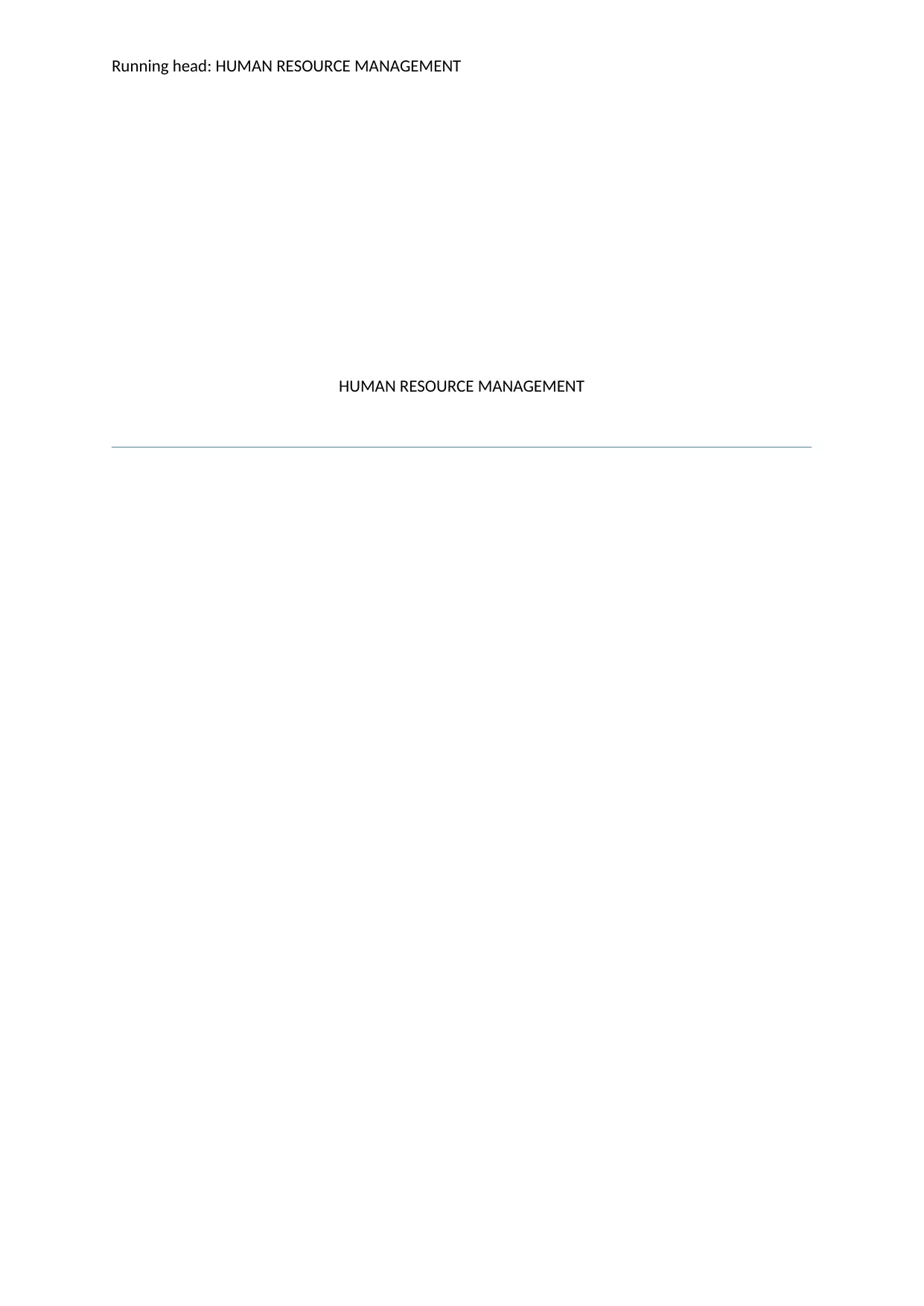
Running head: HUMAN RESOURCE MANAGEMENT
HUMAN RESOURCE MANAGEMENT
HUMAN RESOURCE MANAGEMENT
Paraphrase This Document
Need a fresh take? Get an instant paraphrase of this document with our AI Paraphraser
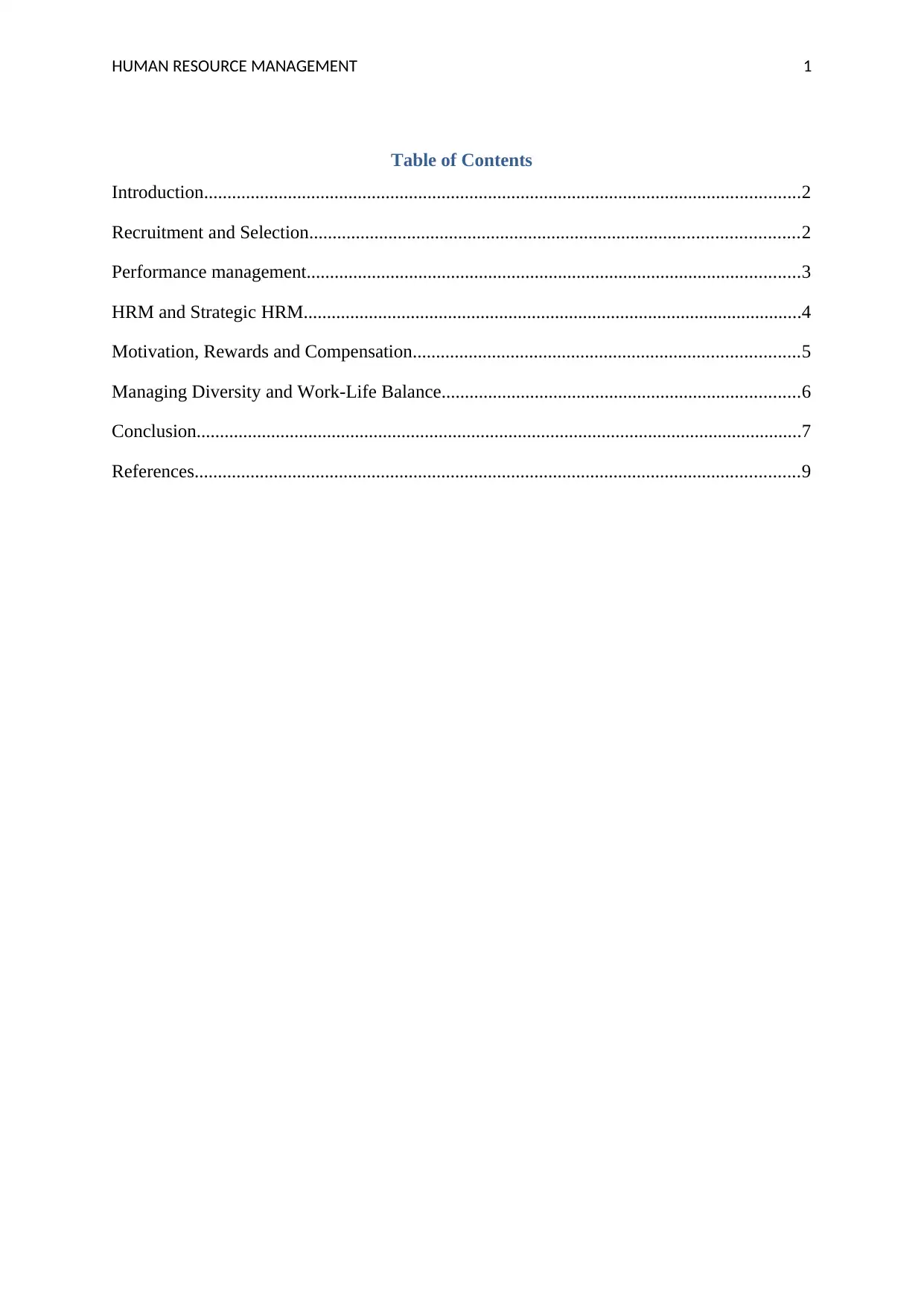
HUMAN RESOURCE MANAGEMENT 1
Table of Contents
Introduction................................................................................................................................2
Recruitment and Selection.........................................................................................................2
Performance management..........................................................................................................3
HRM and Strategic HRM...........................................................................................................4
Motivation, Rewards and Compensation...................................................................................5
Managing Diversity and Work-Life Balance.............................................................................6
Conclusion..................................................................................................................................7
References..................................................................................................................................9
Table of Contents
Introduction................................................................................................................................2
Recruitment and Selection.........................................................................................................2
Performance management..........................................................................................................3
HRM and Strategic HRM...........................................................................................................4
Motivation, Rewards and Compensation...................................................................................5
Managing Diversity and Work-Life Balance.............................................................................6
Conclusion..................................................................................................................................7
References..................................................................................................................................9
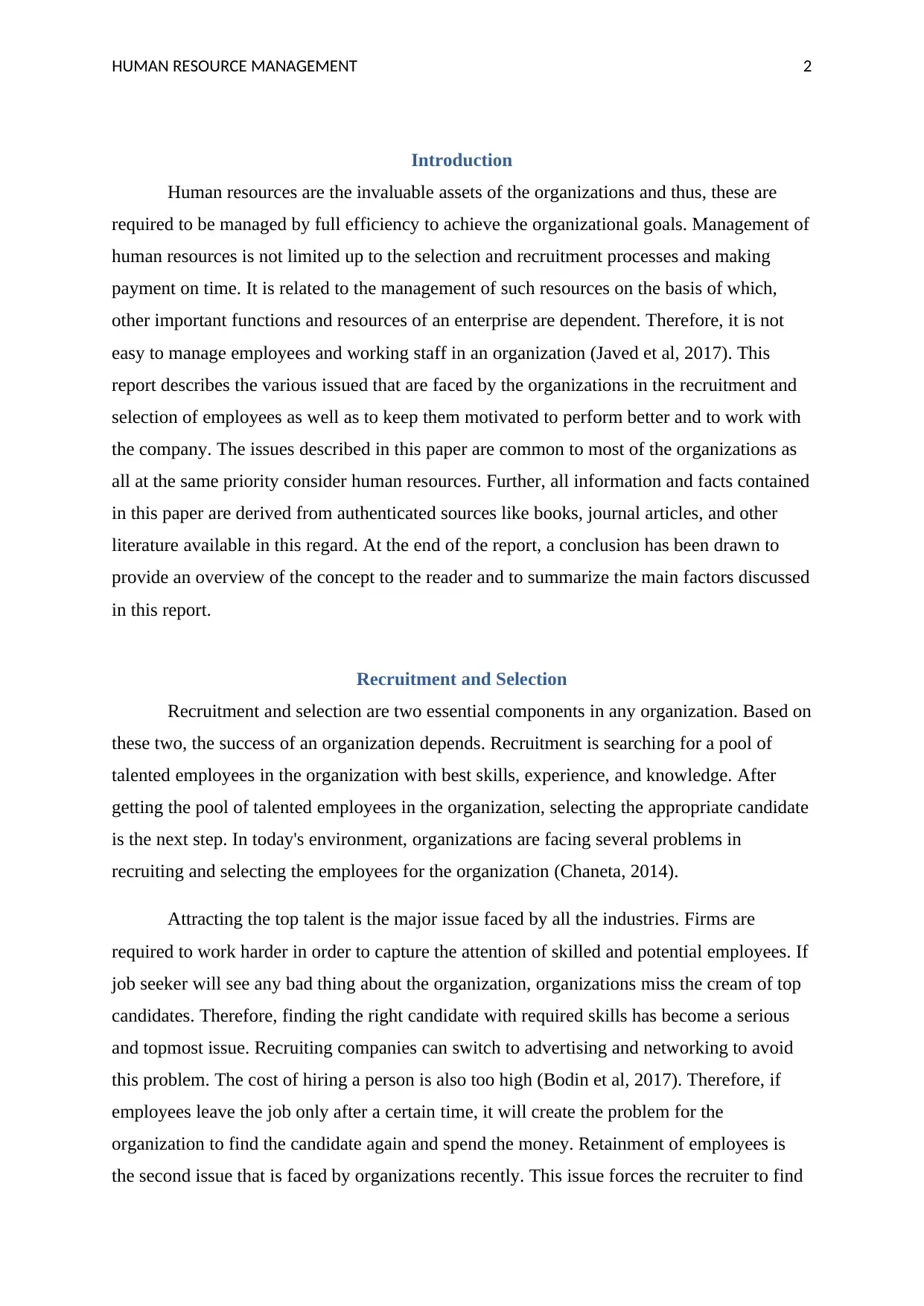
HUMAN RESOURCE MANAGEMENT 2
Introduction
Human resources are the invaluable assets of the organizations and thus, these are
required to be managed by full efficiency to achieve the organizational goals. Management of
human resources is not limited up to the selection and recruitment processes and making
payment on time. It is related to the management of such resources on the basis of which,
other important functions and resources of an enterprise are dependent. Therefore, it is not
easy to manage employees and working staff in an organization (Javed et al, 2017). This
report describes the various issued that are faced by the organizations in the recruitment and
selection of employees as well as to keep them motivated to perform better and to work with
the company. The issues described in this paper are common to most of the organizations as
all at the same priority consider human resources. Further, all information and facts contained
in this paper are derived from authenticated sources like books, journal articles, and other
literature available in this regard. At the end of the report, a conclusion has been drawn to
provide an overview of the concept to the reader and to summarize the main factors discussed
in this report.
Recruitment and Selection
Recruitment and selection are two essential components in any organization. Based on
these two, the success of an organization depends. Recruitment is searching for a pool of
talented employees in the organization with best skills, experience, and knowledge. After
getting the pool of talented employees in the organization, selecting the appropriate candidate
is the next step. In today's environment, organizations are facing several problems in
recruiting and selecting the employees for the organization (Chaneta, 2014).
Attracting the top talent is the major issue faced by all the industries. Firms are
required to work harder in order to capture the attention of skilled and potential employees. If
job seeker will see any bad thing about the organization, organizations miss the cream of top
candidates. Therefore, finding the right candidate with required skills has become a serious
and topmost issue. Recruiting companies can switch to advertising and networking to avoid
this problem. The cost of hiring a person is also too high (Bodin et al, 2017). Therefore, if
employees leave the job only after a certain time, it will create the problem for the
organization to find the candidate again and spend the money. Retainment of employees is
the second issue that is faced by organizations recently. This issue forces the recruiter to find
Introduction
Human resources are the invaluable assets of the organizations and thus, these are
required to be managed by full efficiency to achieve the organizational goals. Management of
human resources is not limited up to the selection and recruitment processes and making
payment on time. It is related to the management of such resources on the basis of which,
other important functions and resources of an enterprise are dependent. Therefore, it is not
easy to manage employees and working staff in an organization (Javed et al, 2017). This
report describes the various issued that are faced by the organizations in the recruitment and
selection of employees as well as to keep them motivated to perform better and to work with
the company. The issues described in this paper are common to most of the organizations as
all at the same priority consider human resources. Further, all information and facts contained
in this paper are derived from authenticated sources like books, journal articles, and other
literature available in this regard. At the end of the report, a conclusion has been drawn to
provide an overview of the concept to the reader and to summarize the main factors discussed
in this report.
Recruitment and Selection
Recruitment and selection are two essential components in any organization. Based on
these two, the success of an organization depends. Recruitment is searching for a pool of
talented employees in the organization with best skills, experience, and knowledge. After
getting the pool of talented employees in the organization, selecting the appropriate candidate
is the next step. In today's environment, organizations are facing several problems in
recruiting and selecting the employees for the organization (Chaneta, 2014).
Attracting the top talent is the major issue faced by all the industries. Firms are
required to work harder in order to capture the attention of skilled and potential employees. If
job seeker will see any bad thing about the organization, organizations miss the cream of top
candidates. Therefore, finding the right candidate with required skills has become a serious
and topmost issue. Recruiting companies can switch to advertising and networking to avoid
this problem. The cost of hiring a person is also too high (Bodin et al, 2017). Therefore, if
employees leave the job only after a certain time, it will create the problem for the
organization to find the candidate again and spend the money. Retainment of employees is
the second issue that is faced by organizations recently. This issue forces the recruiter to find
⊘ This is a preview!⊘
Do you want full access?
Subscribe today to unlock all pages.

Trusted by 1+ million students worldwide
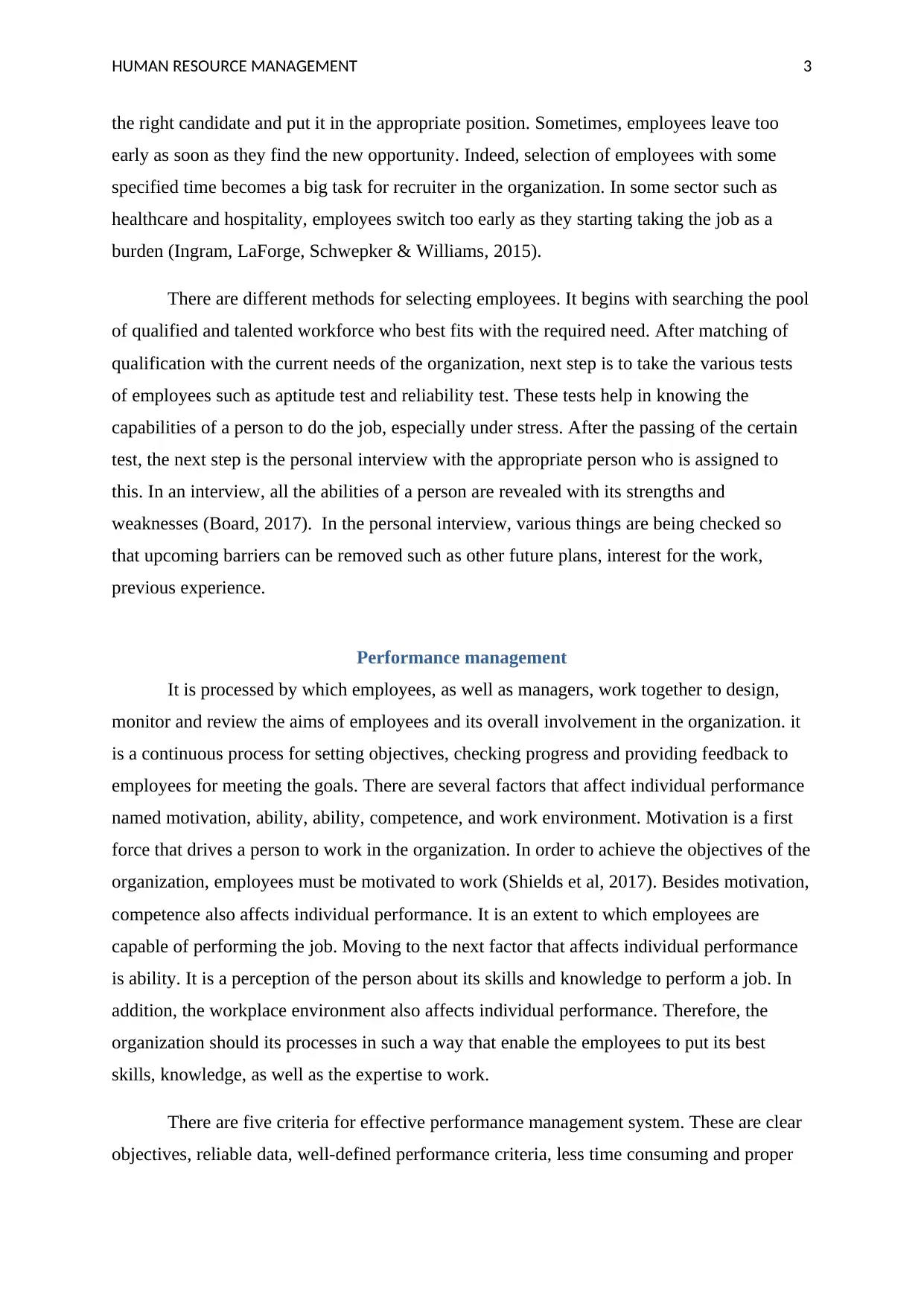
HUMAN RESOURCE MANAGEMENT 3
the right candidate and put it in the appropriate position. Sometimes, employees leave too
early as soon as they find the new opportunity. Indeed, selection of employees with some
specified time becomes a big task for recruiter in the organization. In some sector such as
healthcare and hospitality, employees switch too early as they starting taking the job as a
burden (Ingram, LaForge, Schwepker & Williams, 2015).
There are different methods for selecting employees. It begins with searching the pool
of qualified and talented workforce who best fits with the required need. After matching of
qualification with the current needs of the organization, next step is to take the various tests
of employees such as aptitude test and reliability test. These tests help in knowing the
capabilities of a person to do the job, especially under stress. After the passing of the certain
test, the next step is the personal interview with the appropriate person who is assigned to
this. In an interview, all the abilities of a person are revealed with its strengths and
weaknesses (Board, 2017). In the personal interview, various things are being checked so
that upcoming barriers can be removed such as other future plans, interest for the work,
previous experience.
Performance management
It is processed by which employees, as well as managers, work together to design,
monitor and review the aims of employees and its overall involvement in the organization. it
is a continuous process for setting objectives, checking progress and providing feedback to
employees for meeting the goals. There are several factors that affect individual performance
named motivation, ability, ability, competence, and work environment. Motivation is a first
force that drives a person to work in the organization. In order to achieve the objectives of the
organization, employees must be motivated to work (Shields et al, 2017). Besides motivation,
competence also affects individual performance. It is an extent to which employees are
capable of performing the job. Moving to the next factor that affects individual performance
is ability. It is a perception of the person about its skills and knowledge to perform a job. In
addition, the workplace environment also affects individual performance. Therefore, the
organization should its processes in such a way that enable the employees to put its best
skills, knowledge, as well as the expertise to work.
There are five criteria for effective performance management system. These are clear
objectives, reliable data, well-defined performance criteria, less time consuming and proper
the right candidate and put it in the appropriate position. Sometimes, employees leave too
early as soon as they find the new opportunity. Indeed, selection of employees with some
specified time becomes a big task for recruiter in the organization. In some sector such as
healthcare and hospitality, employees switch too early as they starting taking the job as a
burden (Ingram, LaForge, Schwepker & Williams, 2015).
There are different methods for selecting employees. It begins with searching the pool
of qualified and talented workforce who best fits with the required need. After matching of
qualification with the current needs of the organization, next step is to take the various tests
of employees such as aptitude test and reliability test. These tests help in knowing the
capabilities of a person to do the job, especially under stress. After the passing of the certain
test, the next step is the personal interview with the appropriate person who is assigned to
this. In an interview, all the abilities of a person are revealed with its strengths and
weaknesses (Board, 2017). In the personal interview, various things are being checked so
that upcoming barriers can be removed such as other future plans, interest for the work,
previous experience.
Performance management
It is processed by which employees, as well as managers, work together to design,
monitor and review the aims of employees and its overall involvement in the organization. it
is a continuous process for setting objectives, checking progress and providing feedback to
employees for meeting the goals. There are several factors that affect individual performance
named motivation, ability, ability, competence, and work environment. Motivation is a first
force that drives a person to work in the organization. In order to achieve the objectives of the
organization, employees must be motivated to work (Shields et al, 2017). Besides motivation,
competence also affects individual performance. It is an extent to which employees are
capable of performing the job. Moving to the next factor that affects individual performance
is ability. It is a perception of the person about its skills and knowledge to perform a job. In
addition, the workplace environment also affects individual performance. Therefore, the
organization should its processes in such a way that enable the employees to put its best
skills, knowledge, as well as the expertise to work.
There are five criteria for effective performance management system. These are clear
objectives, reliable data, well-defined performance criteria, less time consuming and proper
Paraphrase This Document
Need a fresh take? Get an instant paraphrase of this document with our AI Paraphraser
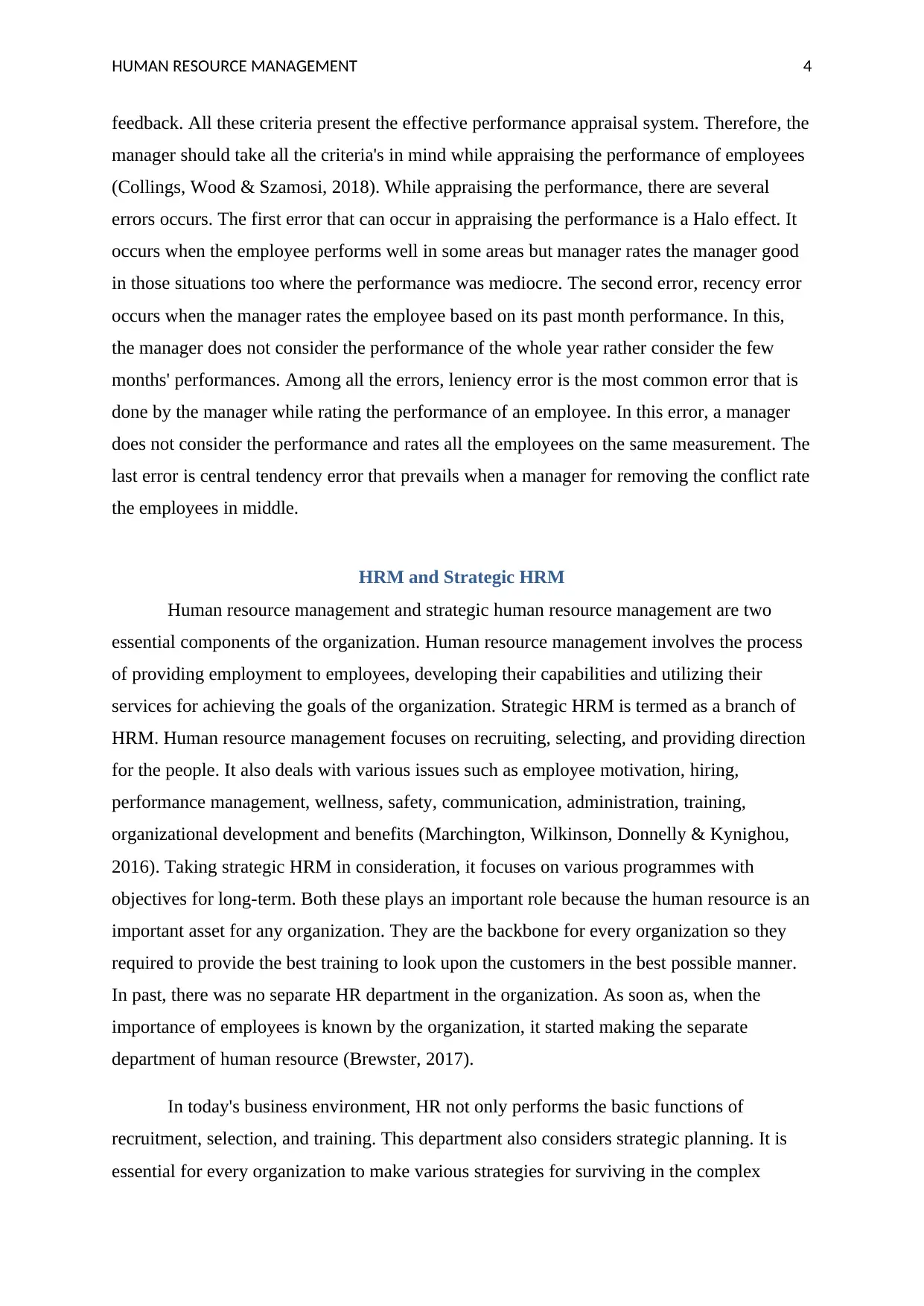
HUMAN RESOURCE MANAGEMENT 4
feedback. All these criteria present the effective performance appraisal system. Therefore, the
manager should take all the criteria's in mind while appraising the performance of employees
(Collings, Wood & Szamosi, 2018). While appraising the performance, there are several
errors occurs. The first error that can occur in appraising the performance is a Halo effect. It
occurs when the employee performs well in some areas but manager rates the manager good
in those situations too where the performance was mediocre. The second error, recency error
occurs when the manager rates the employee based on its past month performance. In this,
the manager does not consider the performance of the whole year rather consider the few
months' performances. Among all the errors, leniency error is the most common error that is
done by the manager while rating the performance of an employee. In this error, a manager
does not consider the performance and rates all the employees on the same measurement. The
last error is central tendency error that prevails when a manager for removing the conflict rate
the employees in middle.
HRM and Strategic HRM
Human resource management and strategic human resource management are two
essential components of the organization. Human resource management involves the process
of providing employment to employees, developing their capabilities and utilizing their
services for achieving the goals of the organization. Strategic HRM is termed as a branch of
HRM. Human resource management focuses on recruiting, selecting, and providing direction
for the people. It also deals with various issues such as employee motivation, hiring,
performance management, wellness, safety, communication, administration, training,
organizational development and benefits (Marchington, Wilkinson, Donnelly & Kynighou,
2016). Taking strategic HRM in consideration, it focuses on various programmes with
objectives for long-term. Both these plays an important role because the human resource is an
important asset for any organization. They are the backbone for every organization so they
required to provide the best training to look upon the customers in the best possible manner.
In past, there was no separate HR department in the organization. As soon as, when the
importance of employees is known by the organization, it started making the separate
department of human resource (Brewster, 2017).
In today's business environment, HR not only performs the basic functions of
recruitment, selection, and training. This department also considers strategic planning. It is
essential for every organization to make various strategies for surviving in the complex
feedback. All these criteria present the effective performance appraisal system. Therefore, the
manager should take all the criteria's in mind while appraising the performance of employees
(Collings, Wood & Szamosi, 2018). While appraising the performance, there are several
errors occurs. The first error that can occur in appraising the performance is a Halo effect. It
occurs when the employee performs well in some areas but manager rates the manager good
in those situations too where the performance was mediocre. The second error, recency error
occurs when the manager rates the employee based on its past month performance. In this,
the manager does not consider the performance of the whole year rather consider the few
months' performances. Among all the errors, leniency error is the most common error that is
done by the manager while rating the performance of an employee. In this error, a manager
does not consider the performance and rates all the employees on the same measurement. The
last error is central tendency error that prevails when a manager for removing the conflict rate
the employees in middle.
HRM and Strategic HRM
Human resource management and strategic human resource management are two
essential components of the organization. Human resource management involves the process
of providing employment to employees, developing their capabilities and utilizing their
services for achieving the goals of the organization. Strategic HRM is termed as a branch of
HRM. Human resource management focuses on recruiting, selecting, and providing direction
for the people. It also deals with various issues such as employee motivation, hiring,
performance management, wellness, safety, communication, administration, training,
organizational development and benefits (Marchington, Wilkinson, Donnelly & Kynighou,
2016). Taking strategic HRM in consideration, it focuses on various programmes with
objectives for long-term. Both these plays an important role because the human resource is an
important asset for any organization. They are the backbone for every organization so they
required to provide the best training to look upon the customers in the best possible manner.
In past, there was no separate HR department in the organization. As soon as, when the
importance of employees is known by the organization, it started making the separate
department of human resource (Brewster, 2017).
In today's business environment, HR not only performs the basic functions of
recruitment, selection, and training. This department also considers strategic planning. It is
essential for every organization to make various strategies for surviving in the complex
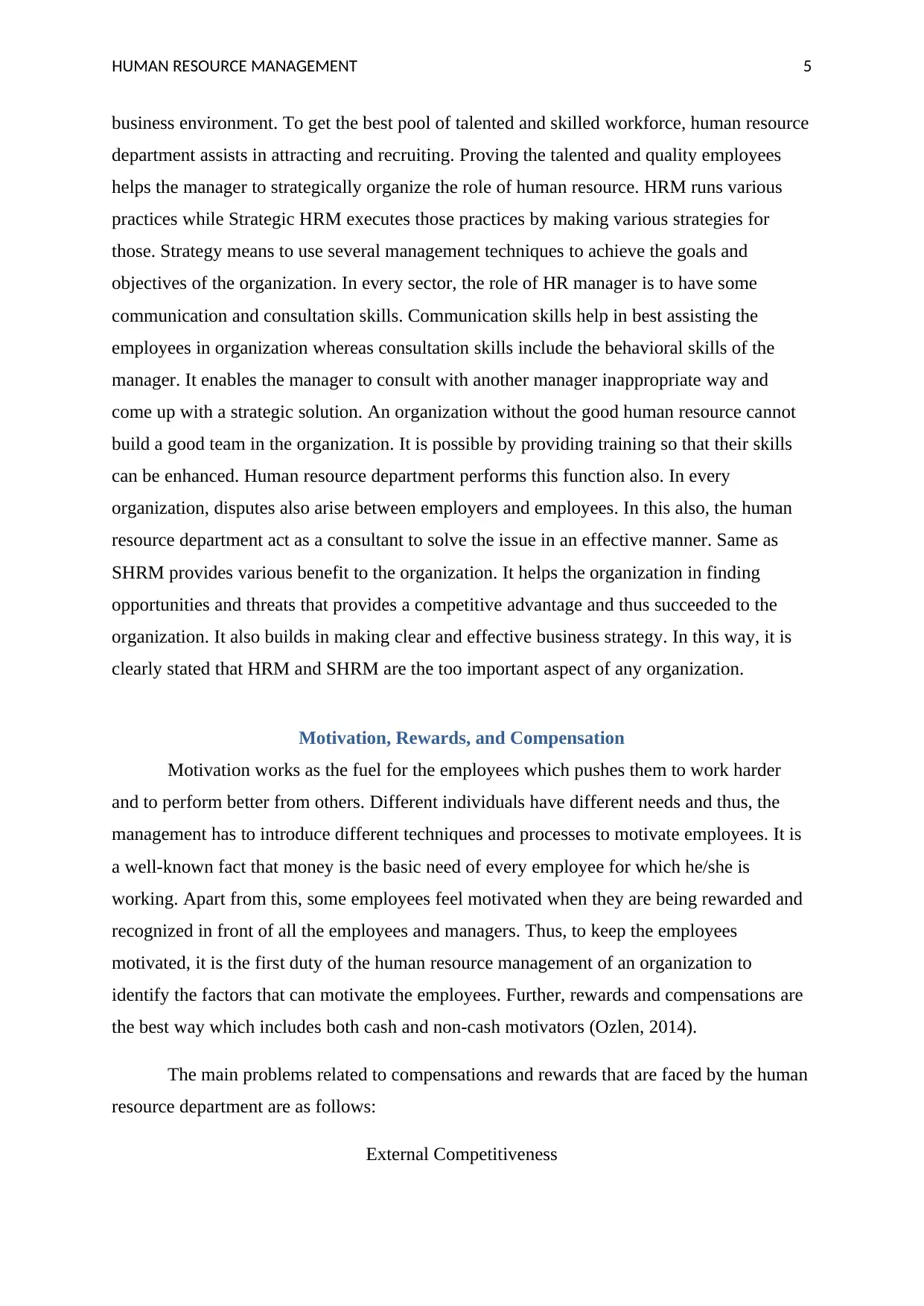
HUMAN RESOURCE MANAGEMENT 5
business environment. To get the best pool of talented and skilled workforce, human resource
department assists in attracting and recruiting. Proving the talented and quality employees
helps the manager to strategically organize the role of human resource. HRM runs various
practices while Strategic HRM executes those practices by making various strategies for
those. Strategy means to use several management techniques to achieve the goals and
objectives of the organization. In every sector, the role of HR manager is to have some
communication and consultation skills. Communication skills help in best assisting the
employees in organization whereas consultation skills include the behavioral skills of the
manager. It enables the manager to consult with another manager inappropriate way and
come up with a strategic solution. An organization without the good human resource cannot
build a good team in the organization. It is possible by providing training so that their skills
can be enhanced. Human resource department performs this function also. In every
organization, disputes also arise between employers and employees. In this also, the human
resource department act as a consultant to solve the issue in an effective manner. Same as
SHRM provides various benefit to the organization. It helps the organization in finding
opportunities and threats that provides a competitive advantage and thus succeeded to the
organization. It also builds in making clear and effective business strategy. In this way, it is
clearly stated that HRM and SHRM are the too important aspect of any organization.
Motivation, Rewards, and Compensation
Motivation works as the fuel for the employees which pushes them to work harder
and to perform better from others. Different individuals have different needs and thus, the
management has to introduce different techniques and processes to motivate employees. It is
a well-known fact that money is the basic need of every employee for which he/she is
working. Apart from this, some employees feel motivated when they are being rewarded and
recognized in front of all the employees and managers. Thus, to keep the employees
motivated, it is the first duty of the human resource management of an organization to
identify the factors that can motivate the employees. Further, rewards and compensations are
the best way which includes both cash and non-cash motivators (Ozlen, 2014).
The main problems related to compensations and rewards that are faced by the human
resource department are as follows:
External Competitiveness
business environment. To get the best pool of talented and skilled workforce, human resource
department assists in attracting and recruiting. Proving the talented and quality employees
helps the manager to strategically organize the role of human resource. HRM runs various
practices while Strategic HRM executes those practices by making various strategies for
those. Strategy means to use several management techniques to achieve the goals and
objectives of the organization. In every sector, the role of HR manager is to have some
communication and consultation skills. Communication skills help in best assisting the
employees in organization whereas consultation skills include the behavioral skills of the
manager. It enables the manager to consult with another manager inappropriate way and
come up with a strategic solution. An organization without the good human resource cannot
build a good team in the organization. It is possible by providing training so that their skills
can be enhanced. Human resource department performs this function also. In every
organization, disputes also arise between employers and employees. In this also, the human
resource department act as a consultant to solve the issue in an effective manner. Same as
SHRM provides various benefit to the organization. It helps the organization in finding
opportunities and threats that provides a competitive advantage and thus succeeded to the
organization. It also builds in making clear and effective business strategy. In this way, it is
clearly stated that HRM and SHRM are the too important aspect of any organization.
Motivation, Rewards, and Compensation
Motivation works as the fuel for the employees which pushes them to work harder
and to perform better from others. Different individuals have different needs and thus, the
management has to introduce different techniques and processes to motivate employees. It is
a well-known fact that money is the basic need of every employee for which he/she is
working. Apart from this, some employees feel motivated when they are being rewarded and
recognized in front of all the employees and managers. Thus, to keep the employees
motivated, it is the first duty of the human resource management of an organization to
identify the factors that can motivate the employees. Further, rewards and compensations are
the best way which includes both cash and non-cash motivators (Ozlen, 2014).
The main problems related to compensations and rewards that are faced by the human
resource department are as follows:
External Competitiveness
⊘ This is a preview!⊘
Do you want full access?
Subscribe today to unlock all pages.

Trusted by 1+ million students worldwide
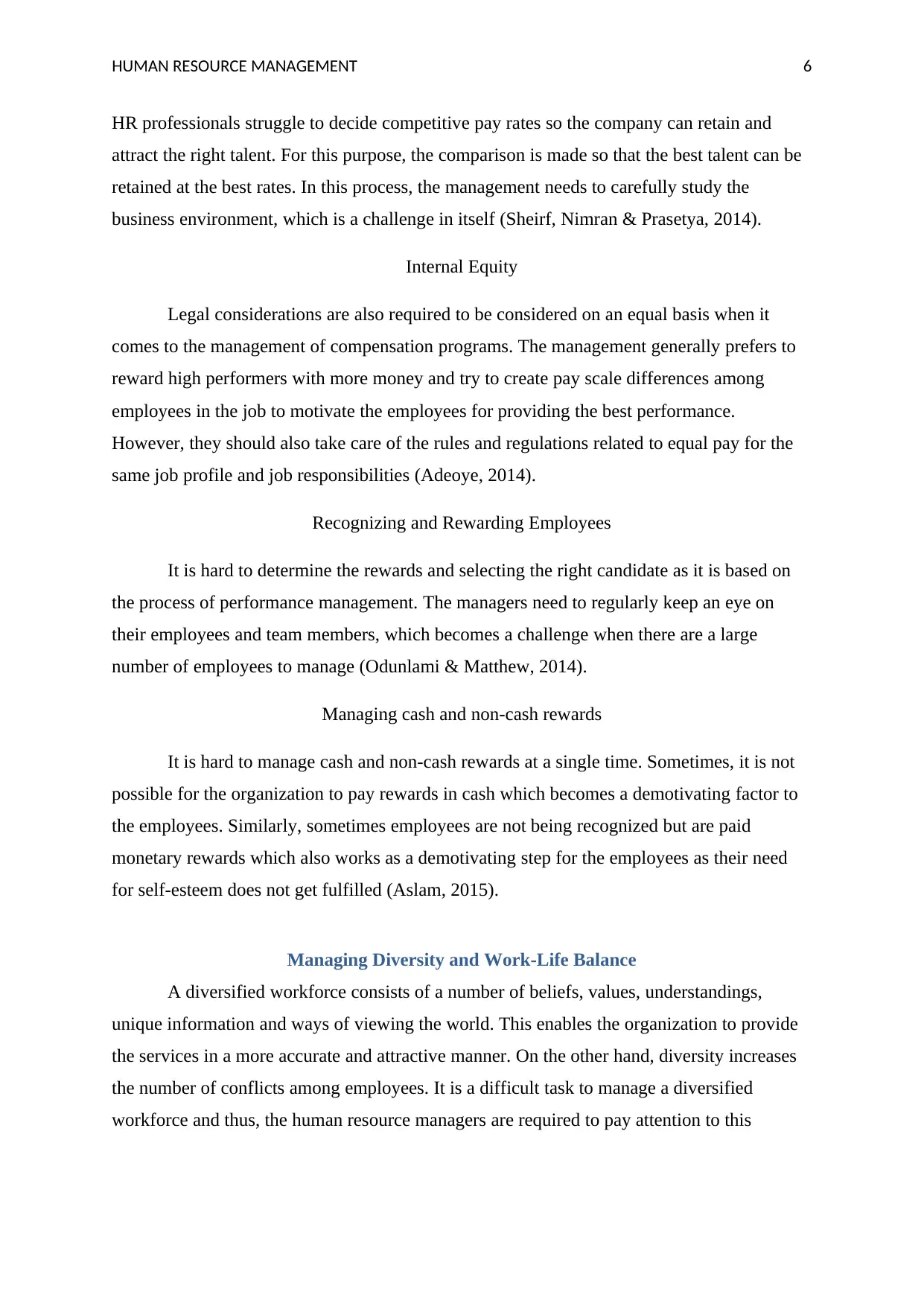
HUMAN RESOURCE MANAGEMENT 6
HR professionals struggle to decide competitive pay rates so the company can retain and
attract the right talent. For this purpose, the comparison is made so that the best talent can be
retained at the best rates. In this process, the management needs to carefully study the
business environment, which is a challenge in itself (Sheirf, Nimran & Prasetya, 2014).
Internal Equity
Legal considerations are also required to be considered on an equal basis when it
comes to the management of compensation programs. The management generally prefers to
reward high performers with more money and try to create pay scale differences among
employees in the job to motivate the employees for providing the best performance.
However, they should also take care of the rules and regulations related to equal pay for the
same job profile and job responsibilities (Adeoye, 2014).
Recognizing and Rewarding Employees
It is hard to determine the rewards and selecting the right candidate as it is based on
the process of performance management. The managers need to regularly keep an eye on
their employees and team members, which becomes a challenge when there are a large
number of employees to manage (Odunlami & Matthew, 2014).
Managing cash and non-cash rewards
It is hard to manage cash and non-cash rewards at a single time. Sometimes, it is not
possible for the organization to pay rewards in cash which becomes a demotivating factor to
the employees. Similarly, sometimes employees are not being recognized but are paid
monetary rewards which also works as a demotivating step for the employees as their need
for self-esteem does not get fulfilled (Aslam, 2015).
Managing Diversity and Work-Life Balance
A diversified workforce consists of a number of beliefs, values, understandings,
unique information and ways of viewing the world. This enables the organization to provide
the services in a more accurate and attractive manner. On the other hand, diversity increases
the number of conflicts among employees. It is a difficult task to manage a diversified
workforce and thus, the human resource managers are required to pay attention to this
HR professionals struggle to decide competitive pay rates so the company can retain and
attract the right talent. For this purpose, the comparison is made so that the best talent can be
retained at the best rates. In this process, the management needs to carefully study the
business environment, which is a challenge in itself (Sheirf, Nimran & Prasetya, 2014).
Internal Equity
Legal considerations are also required to be considered on an equal basis when it
comes to the management of compensation programs. The management generally prefers to
reward high performers with more money and try to create pay scale differences among
employees in the job to motivate the employees for providing the best performance.
However, they should also take care of the rules and regulations related to equal pay for the
same job profile and job responsibilities (Adeoye, 2014).
Recognizing and Rewarding Employees
It is hard to determine the rewards and selecting the right candidate as it is based on
the process of performance management. The managers need to regularly keep an eye on
their employees and team members, which becomes a challenge when there are a large
number of employees to manage (Odunlami & Matthew, 2014).
Managing cash and non-cash rewards
It is hard to manage cash and non-cash rewards at a single time. Sometimes, it is not
possible for the organization to pay rewards in cash which becomes a demotivating factor to
the employees. Similarly, sometimes employees are not being recognized but are paid
monetary rewards which also works as a demotivating step for the employees as their need
for self-esteem does not get fulfilled (Aslam, 2015).
Managing Diversity and Work-Life Balance
A diversified workforce consists of a number of beliefs, values, understandings,
unique information and ways of viewing the world. This enables the organization to provide
the services in a more accurate and attractive manner. On the other hand, diversity increases
the number of conflicts among employees. It is a difficult task to manage a diversified
workforce and thus, the human resource managers are required to pay attention to this
Paraphrase This Document
Need a fresh take? Get an instant paraphrase of this document with our AI Paraphraser
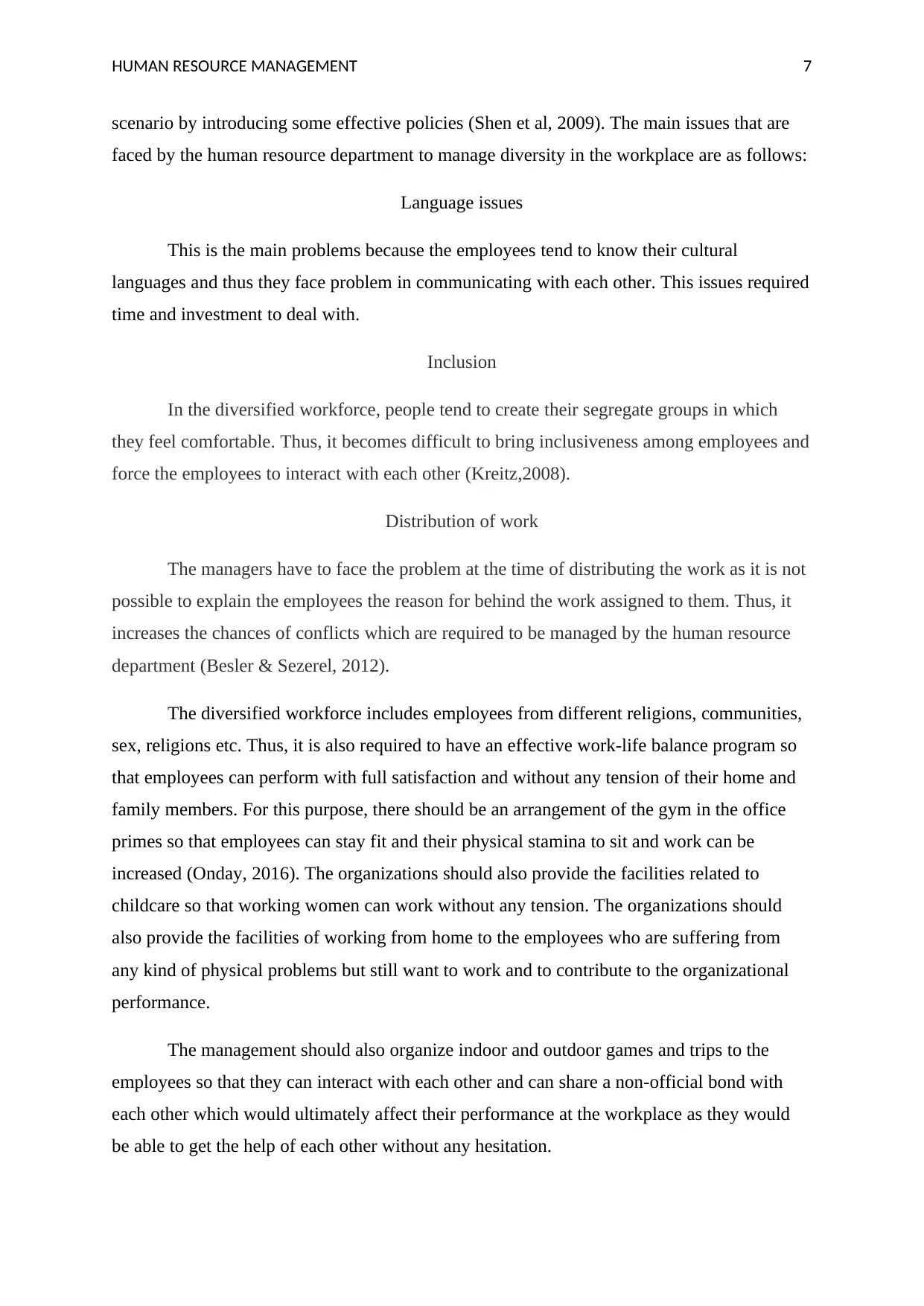
HUMAN RESOURCE MANAGEMENT 7
scenario by introducing some effective policies (Shen et al, 2009). The main issues that are
faced by the human resource department to manage diversity in the workplace are as follows:
Language issues
This is the main problems because the employees tend to know their cultural
languages and thus they face problem in communicating with each other. This issues required
time and investment to deal with.
Inclusion
In the diversified workforce, people tend to create their segregate groups in which
they feel comfortable. Thus, it becomes difficult to bring inclusiveness among employees and
force the employees to interact with each other (Kreitz,2008).
Distribution of work
The managers have to face the problem at the time of distributing the work as it is not
possible to explain the employees the reason for behind the work assigned to them. Thus, it
increases the chances of conflicts which are required to be managed by the human resource
department (Besler & Sezerel, 2012).
The diversified workforce includes employees from different religions, communities,
sex, religions etc. Thus, it is also required to have an effective work-life balance program so
that employees can perform with full satisfaction and without any tension of their home and
family members. For this purpose, there should be an arrangement of the gym in the office
primes so that employees can stay fit and their physical stamina to sit and work can be
increased (Onday, 2016). The organizations should also provide the facilities related to
childcare so that working women can work without any tension. The organizations should
also provide the facilities of working from home to the employees who are suffering from
any kind of physical problems but still want to work and to contribute to the organizational
performance.
The management should also organize indoor and outdoor games and trips to the
employees so that they can interact with each other and can share a non-official bond with
each other which would ultimately affect their performance at the workplace as they would
be able to get the help of each other without any hesitation.
scenario by introducing some effective policies (Shen et al, 2009). The main issues that are
faced by the human resource department to manage diversity in the workplace are as follows:
Language issues
This is the main problems because the employees tend to know their cultural
languages and thus they face problem in communicating with each other. This issues required
time and investment to deal with.
Inclusion
In the diversified workforce, people tend to create their segregate groups in which
they feel comfortable. Thus, it becomes difficult to bring inclusiveness among employees and
force the employees to interact with each other (Kreitz,2008).
Distribution of work
The managers have to face the problem at the time of distributing the work as it is not
possible to explain the employees the reason for behind the work assigned to them. Thus, it
increases the chances of conflicts which are required to be managed by the human resource
department (Besler & Sezerel, 2012).
The diversified workforce includes employees from different religions, communities,
sex, religions etc. Thus, it is also required to have an effective work-life balance program so
that employees can perform with full satisfaction and without any tension of their home and
family members. For this purpose, there should be an arrangement of the gym in the office
primes so that employees can stay fit and their physical stamina to sit and work can be
increased (Onday, 2016). The organizations should also provide the facilities related to
childcare so that working women can work without any tension. The organizations should
also provide the facilities of working from home to the employees who are suffering from
any kind of physical problems but still want to work and to contribute to the organizational
performance.
The management should also organize indoor and outdoor games and trips to the
employees so that they can interact with each other and can share a non-official bond with
each other which would ultimately affect their performance at the workplace as they would
be able to get the help of each other without any hesitation.

HUMAN RESOURCE MANAGEMENT 8
Conclusion
On the basis of the above study, it can be concluded that human resource management
includes a number of areas to be managed under it. The efficient management of human
resources in the main responsibility of any organization as human resources are the main
assets. From the selection to the retaining, each aspect is related to the management of
employees. The report concludes main problems faced by the management at the time of
recruiting and selecting the employees along with the key methods that are used to select the
appropriate employees. Further, it concludes the problems faced by the management in
measuring the performance of the employees and the main methods that are being adopted for
measuring the performance of employees. Along with this, this paper also includes the main
challenges faced by the organizations in motivating the employees through rewards and
compensations. Management of diversity and work-life balance has also been discussed as
this is one of the main emerging issues to the human resource department of the companies.
In the end, the concept and problems related to strategic human resource management have
been discussed to show that what problems are being faced by the management to link the
human resource management policies to the strategic policies of the organizations.
Conclusion
On the basis of the above study, it can be concluded that human resource management
includes a number of areas to be managed under it. The efficient management of human
resources in the main responsibility of any organization as human resources are the main
assets. From the selection to the retaining, each aspect is related to the management of
employees. The report concludes main problems faced by the management at the time of
recruiting and selecting the employees along with the key methods that are used to select the
appropriate employees. Further, it concludes the problems faced by the management in
measuring the performance of the employees and the main methods that are being adopted for
measuring the performance of employees. Along with this, this paper also includes the main
challenges faced by the organizations in motivating the employees through rewards and
compensations. Management of diversity and work-life balance has also been discussed as
this is one of the main emerging issues to the human resource department of the companies.
In the end, the concept and problems related to strategic human resource management have
been discussed to show that what problems are being faced by the management to link the
human resource management policies to the strategic policies of the organizations.
⊘ This is a preview!⊘
Do you want full access?
Subscribe today to unlock all pages.

Trusted by 1+ million students worldwide
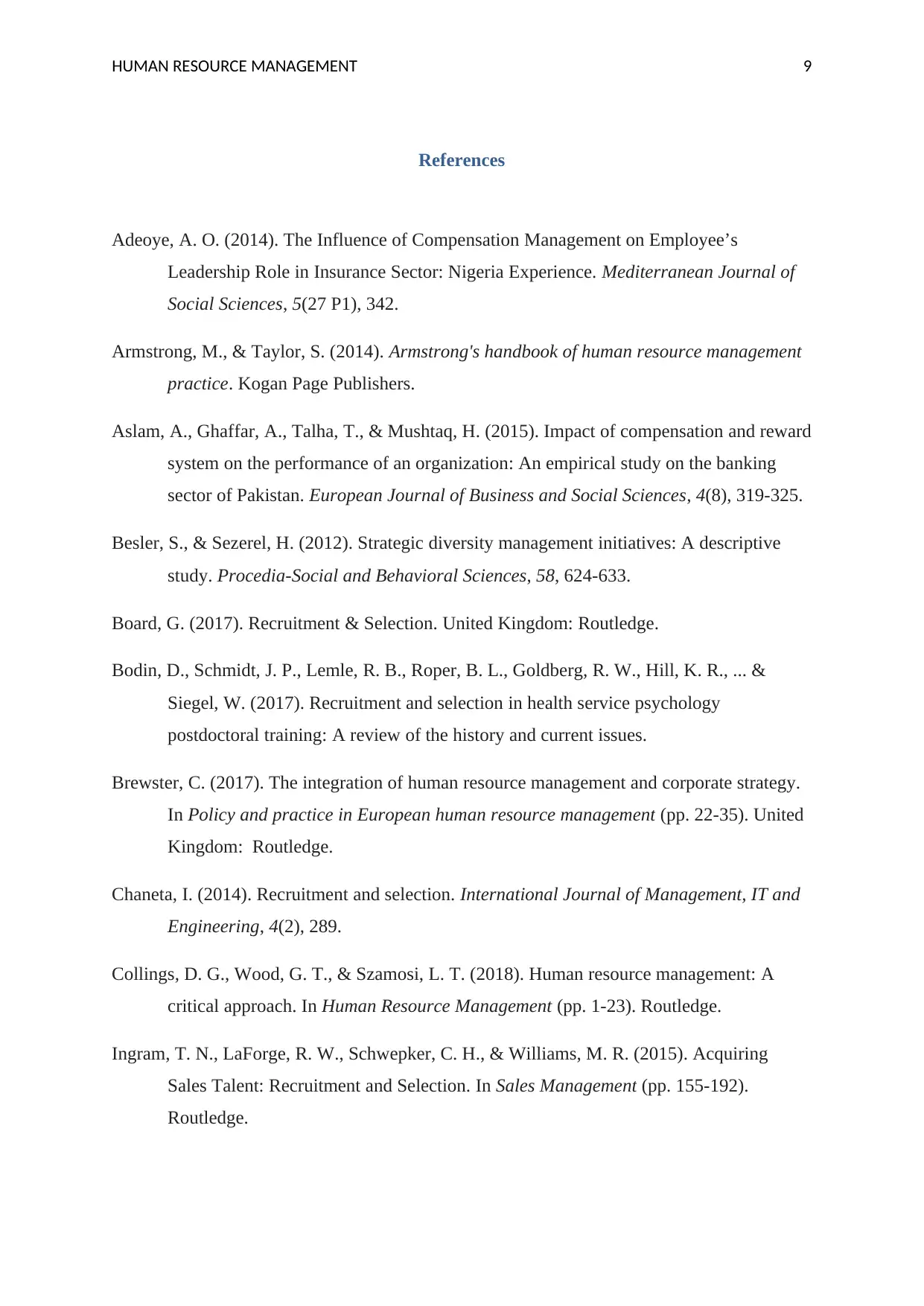
HUMAN RESOURCE MANAGEMENT 9
References
Adeoye, A. O. (2014). The Influence of Compensation Management on Employee’s
Leadership Role in Insurance Sector: Nigeria Experience. Mediterranean Journal of
Social Sciences, 5(27 P1), 342.
Armstrong, M., & Taylor, S. (2014). Armstrong's handbook of human resource management
practice. Kogan Page Publishers.
Aslam, A., Ghaffar, A., Talha, T., & Mushtaq, H. (2015). Impact of compensation and reward
system on the performance of an organization: An empirical study on the banking
sector of Pakistan. European Journal of Business and Social Sciences, 4(8), 319-325.
Besler, S., & Sezerel, H. (2012). Strategic diversity management initiatives: A descriptive
study. Procedia-Social and Behavioral Sciences, 58, 624-633.
Board, G. (2017). Recruitment & Selection. United Kingdom: Routledge.
Bodin, D., Schmidt, J. P., Lemle, R. B., Roper, B. L., Goldberg, R. W., Hill, K. R., ... &
Siegel, W. (2017). Recruitment and selection in health service psychology
postdoctoral training: A review of the history and current issues.
Brewster, C. (2017). The integration of human resource management and corporate strategy.
In Policy and practice in European human resource management (pp. 22-35). United
Kingdom: Routledge.
Chaneta, I. (2014). Recruitment and selection. International Journal of Management, IT and
Engineering, 4(2), 289.
Collings, D. G., Wood, G. T., & Szamosi, L. T. (2018). Human resource management: A
critical approach. In Human Resource Management (pp. 1-23). Routledge.
Ingram, T. N., LaForge, R. W., Schwepker, C. H., & Williams, M. R. (2015). Acquiring
Sales Talent: Recruitment and Selection. In Sales Management (pp. 155-192).
Routledge.
References
Adeoye, A. O. (2014). The Influence of Compensation Management on Employee’s
Leadership Role in Insurance Sector: Nigeria Experience. Mediterranean Journal of
Social Sciences, 5(27 P1), 342.
Armstrong, M., & Taylor, S. (2014). Armstrong's handbook of human resource management
practice. Kogan Page Publishers.
Aslam, A., Ghaffar, A., Talha, T., & Mushtaq, H. (2015). Impact of compensation and reward
system on the performance of an organization: An empirical study on the banking
sector of Pakistan. European Journal of Business and Social Sciences, 4(8), 319-325.
Besler, S., & Sezerel, H. (2012). Strategic diversity management initiatives: A descriptive
study. Procedia-Social and Behavioral Sciences, 58, 624-633.
Board, G. (2017). Recruitment & Selection. United Kingdom: Routledge.
Bodin, D., Schmidt, J. P., Lemle, R. B., Roper, B. L., Goldberg, R. W., Hill, K. R., ... &
Siegel, W. (2017). Recruitment and selection in health service psychology
postdoctoral training: A review of the history and current issues.
Brewster, C. (2017). The integration of human resource management and corporate strategy.
In Policy and practice in European human resource management (pp. 22-35). United
Kingdom: Routledge.
Chaneta, I. (2014). Recruitment and selection. International Journal of Management, IT and
Engineering, 4(2), 289.
Collings, D. G., Wood, G. T., & Szamosi, L. T. (2018). Human resource management: A
critical approach. In Human Resource Management (pp. 1-23). Routledge.
Ingram, T. N., LaForge, R. W., Schwepker, C. H., & Williams, M. R. (2015). Acquiring
Sales Talent: Recruitment and Selection. In Sales Management (pp. 155-192).
Routledge.
Paraphrase This Document
Need a fresh take? Get an instant paraphrase of this document with our AI Paraphraser
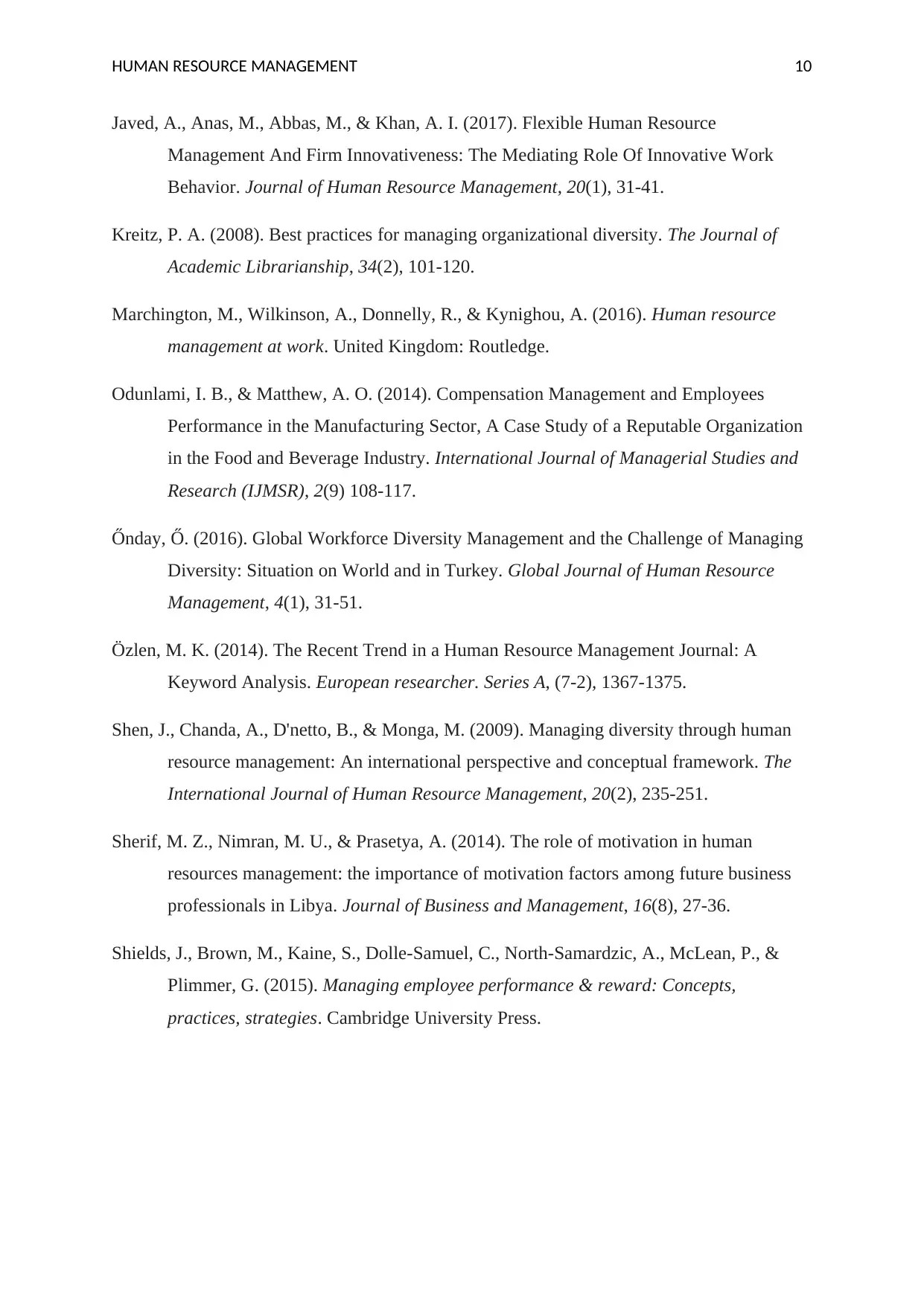
HUMAN RESOURCE MANAGEMENT 10
Javed, A., Anas, M., Abbas, M., & Khan, A. I. (2017). Flexible Human Resource
Management And Firm Innovativeness: The Mediating Role Of Innovative Work
Behavior. Journal of Human Resource Management, 20(1), 31-41.
Kreitz, P. A. (2008). Best practices for managing organizational diversity. The Journal of
Academic Librarianship, 34(2), 101-120.
Marchington, M., Wilkinson, A., Donnelly, R., & Kynighou, A. (2016). Human resource
management at work. United Kingdom: Routledge.
Odunlami, I. B., & Matthew, A. O. (2014). Compensation Management and Employees
Performance in the Manufacturing Sector, A Case Study of a Reputable Organization
in the Food and Beverage Industry. International Journal of Managerial Studies and
Research (IJMSR), 2(9) 108-117.
Őnday, Ő. (2016). Global Workforce Diversity Management and the Challenge of Managing
Diversity: Situation on World and in Turkey. Global Journal of Human Resource
Management, 4(1), 31-51.
Özlen, M. K. (2014). The Recent Trend in a Human Resource Management Journal: A
Keyword Analysis. European researcher. Series A, (7-2), 1367-1375.
Shen, J., Chanda, A., D'netto, B., & Monga, M. (2009). Managing diversity through human
resource management: An international perspective and conceptual framework. The
International Journal of Human Resource Management, 20(2), 235-251.
Sherif, M. Z., Nimran, M. U., & Prasetya, A. (2014). The role of motivation in human
resources management: the importance of motivation factors among future business
professionals in Libya. Journal of Business and Management, 16(8), 27-36.
Shields, J., Brown, M., Kaine, S., Dolle-Samuel, C., North-Samardzic, A., McLean, P., &
Plimmer, G. (2015). Managing employee performance & reward: Concepts,
practices, strategies. Cambridge University Press.
Javed, A., Anas, M., Abbas, M., & Khan, A. I. (2017). Flexible Human Resource
Management And Firm Innovativeness: The Mediating Role Of Innovative Work
Behavior. Journal of Human Resource Management, 20(1), 31-41.
Kreitz, P. A. (2008). Best practices for managing organizational diversity. The Journal of
Academic Librarianship, 34(2), 101-120.
Marchington, M., Wilkinson, A., Donnelly, R., & Kynighou, A. (2016). Human resource
management at work. United Kingdom: Routledge.
Odunlami, I. B., & Matthew, A. O. (2014). Compensation Management and Employees
Performance in the Manufacturing Sector, A Case Study of a Reputable Organization
in the Food and Beverage Industry. International Journal of Managerial Studies and
Research (IJMSR), 2(9) 108-117.
Őnday, Ő. (2016). Global Workforce Diversity Management and the Challenge of Managing
Diversity: Situation on World and in Turkey. Global Journal of Human Resource
Management, 4(1), 31-51.
Özlen, M. K. (2014). The Recent Trend in a Human Resource Management Journal: A
Keyword Analysis. European researcher. Series A, (7-2), 1367-1375.
Shen, J., Chanda, A., D'netto, B., & Monga, M. (2009). Managing diversity through human
resource management: An international perspective and conceptual framework. The
International Journal of Human Resource Management, 20(2), 235-251.
Sherif, M. Z., Nimran, M. U., & Prasetya, A. (2014). The role of motivation in human
resources management: the importance of motivation factors among future business
professionals in Libya. Journal of Business and Management, 16(8), 27-36.
Shields, J., Brown, M., Kaine, S., Dolle-Samuel, C., North-Samardzic, A., McLean, P., &
Plimmer, G. (2015). Managing employee performance & reward: Concepts,
practices, strategies. Cambridge University Press.
1 out of 11
Related Documents
Your All-in-One AI-Powered Toolkit for Academic Success.
+13062052269
info@desklib.com
Available 24*7 on WhatsApp / Email
![[object Object]](/_next/static/media/star-bottom.7253800d.svg)
Unlock your academic potential
Copyright © 2020–2025 A2Z Services. All Rights Reserved. Developed and managed by ZUCOL.



